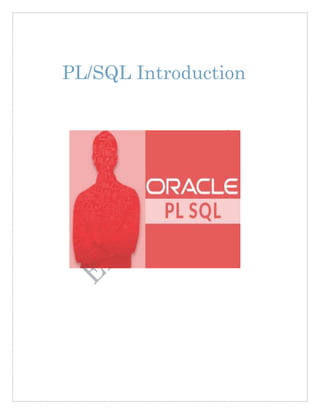Signaler
Partager
Télécharger pour lire hors ligne

Recommandé
Recommandé
Contenu connexe
Tendances
Tendances (18)
Oracle PL/SQL online training | PL/SQL online Training

Oracle PL/SQL online training | PL/SQL online Training
En vedette
En vedette (15)
Why SoftLayer? なぜ、EC/通販統合パッケージリーダーのエルテックスは、SoftLayerを選んだのか?

Why SoftLayer? なぜ、EC/通販統合パッケージリーダーのエルテックスは、SoftLayerを選んだのか?
Similaire à Pl sql
Lecture notes for Unit-5 "PL/SQL, Cursor and Trigger" for semester Summer-2020B.Sc. II (IV Sem) RDBMS & PL/SQL Unit-5 PL/SQL, Cursor and Trigger

B.Sc. II (IV Sem) RDBMS & PL/SQL Unit-5 PL/SQL, Cursor and TriggerAssistant Professor, Shri Shivaji Science College, Amravati
Similaire à Pl sql (20)
What does PL_SQL stand for and what is the functioning of PL_SQL.docx

What does PL_SQL stand for and what is the functioning of PL_SQL.docx
B.Sc. II (IV Sem) RDBMS & PL/SQL Unit-5 PL/SQL, Cursor and Trigger

B.Sc. II (IV Sem) RDBMS & PL/SQL Unit-5 PL/SQL, Cursor and Trigger
Cordova training : Day 3 - Introduction to Javascript

Cordova training : Day 3 - Introduction to Javascript
Plus de nikhilsh66131
Plus de nikhilsh66131 (7)
Dernier
https://app.box.com/s/x7vf0j7xaxl2hlczxm3ny497y4yto33i80 ĐỀ THI THỬ TUYỂN SINH TIẾNG ANH VÀO 10 SỞ GD – ĐT THÀNH PHỐ HỒ CHÍ MINH NĂ...

80 ĐỀ THI THỬ TUYỂN SINH TIẾNG ANH VÀO 10 SỞ GD – ĐT THÀNH PHỐ HỒ CHÍ MINH NĂ...Nguyen Thanh Tu Collection
Mehran University Newsletter is a Quarterly Publication from Public Relations OfficeMehran University Newsletter Vol-X, Issue-I, 2024

Mehran University Newsletter Vol-X, Issue-I, 2024Mehran University of Engineering & Technology, Jamshoro
Dernier (20)
UGC NET Paper 1 Mathematical Reasoning & Aptitude.pdf

UGC NET Paper 1 Mathematical Reasoning & Aptitude.pdf
Unit 3 Emotional Intelligence and Spiritual Intelligence.pdf

Unit 3 Emotional Intelligence and Spiritual Intelligence.pdf
Sensory_Experience_and_Emotional_Resonance_in_Gabriel_Okaras_The_Piano_and_Th...

Sensory_Experience_and_Emotional_Resonance_in_Gabriel_Okaras_The_Piano_and_Th...
Basic Civil Engineering first year Notes- Chapter 4 Building.pptx

Basic Civil Engineering first year Notes- Chapter 4 Building.pptx
80 ĐỀ THI THỬ TUYỂN SINH TIẾNG ANH VÀO 10 SỞ GD – ĐT THÀNH PHỐ HỒ CHÍ MINH NĂ...

80 ĐỀ THI THỬ TUYỂN SINH TIẾNG ANH VÀO 10 SỞ GD – ĐT THÀNH PHỐ HỒ CHÍ MINH NĂ...
General Principles of Intellectual Property: Concepts of Intellectual Proper...

General Principles of Intellectual Property: Concepts of Intellectual Proper...
Micro-Scholarship, What it is, How can it help me.pdf

Micro-Scholarship, What it is, How can it help me.pdf
Salient Features of India constitution especially power and functions

Salient Features of India constitution especially power and functions
Interdisciplinary_Insights_Data_Collection_Methods.pptx

Interdisciplinary_Insights_Data_Collection_Methods.pptx
Food safety_Challenges food safety laboratories_.pdf

Food safety_Challenges food safety laboratories_.pdf
Pl sql
- 2. Q.> What is PL/SQL? Ans.> PL/SQL (Procedural Language/Structured Query Language) is Oracle Corporation's procedural extension for SQL and the Oracle relational database. PL/SQL is available in Oracle Database (since version 7). PL/SQL (Procedural Language extensions to SQL) is designed specifically for the seamless processing of SQL commands. PL/SQL stored and compiled in the database, runs within the Oracle executable and inherits the robustness, security, and portability of the Oracle Database. PL/SQL is a combination of SQL along with the procedural features of programming languages. Features of PL/SQL block (modular) structure flow-control statements and loops variables, constants, and types structured data customized error handling it allows you to store compiled code directly in the database. once a given block of code is loaded into memory, any number of users can use the same copy of it simultaneously (although behavior is as though each user had her own copy), which is useful for the Oracle WebServer. enables you to define triggers, which are subprograms that the database executes automatically in response to specified events. is tightly integrated with SQL. offers extensive error checking. supports object-oriented programming. It supports developing web applications and server pages.
- 3. PL/SQL Syntax PL/SQL block consists of three sub-parts: DECLARATIONS EXECUTABLE COMMANDS EXCEPTION HANDLING DECLARATIONS This section includes the declarations for variables, cursors, sub-programs, and other elements to be used in the program. This section starts with DECLARE keyword. This section is optional. EXECUTABLE COMMANDS This section includes executable PL/SQL statements of the program. It should have at least one executable line of code. This section starts with BEGIN keyword and ends with END; keyword. This section is mandatory. EXCEPTION HANDLING This section includes exception(s) that handle errors in the program. This section starts with EXCEPTION keyword and is placed between BEGIN and END; Basic structure: DECLARE <declarations sections> BEGIN <executable command(s)> EXCEPTION <exception handling> END; Using Comments: Single line comments: Single line comments can be written as: -- Single line Comment Multi-line comments: Multi-line comments can be written as: /* Multi-line Comment */
- 4. Declaring Variables: Syntax: Variable_name data_type; Or Variable_name data_type:=value; Or Variable_name data_type DEFAULT value; For example: vSalary number; or vSalary number:=1000; or vSalary number DEFAULT 1000; You can also use CONSTANT and NOT NULL as: Variable_name CONSTANT data_type NOT NULL :=value; For example: vMax CONSTANT number NOT NULL:=100; When you use CONSTANT or NOT NULL then you must initialize the variable. PL/SQL identifiers are constants, variables, exceptions, procedures, cursors, and reserved words. The identifiers consist of a letter optionally followed by more letters, numerals, dollar signs, underscores, and number signs and should not exceed 30 characters. By default, identifiers are not case-sensitive. So you can use integer or INTEGER to represent a numeric value. You cannot use a reserved keyword as an identifier.
- 5. Printing a message To print a message use: dbms_output.put_line(‘message’); To concatenate use || dbms_output.put_line(‘message1’||’message2’); dbms_output.put_line(‘Employee Id: ’||65489); To print value of a variable use: dbms_output.put_line(‘Value: ’||variable_name); Sample PL/SQL Program: DECLARE vMessage varchar2(50):=’Welcome to PL/SQL’; BEGIN dbms_output.put_line(vMessage); END; / The END; line signals the end of the PL/SQL block. To run the code from SQL command line, you may need to type / at the beginning of the first blank line after the last line of the code. When the above code is executed at SQL prompt, it produces the following result: Welcome to PL/SQL PL/SQL procedure successfully completed. Visit: http://pictorialpoint.blogspot.in